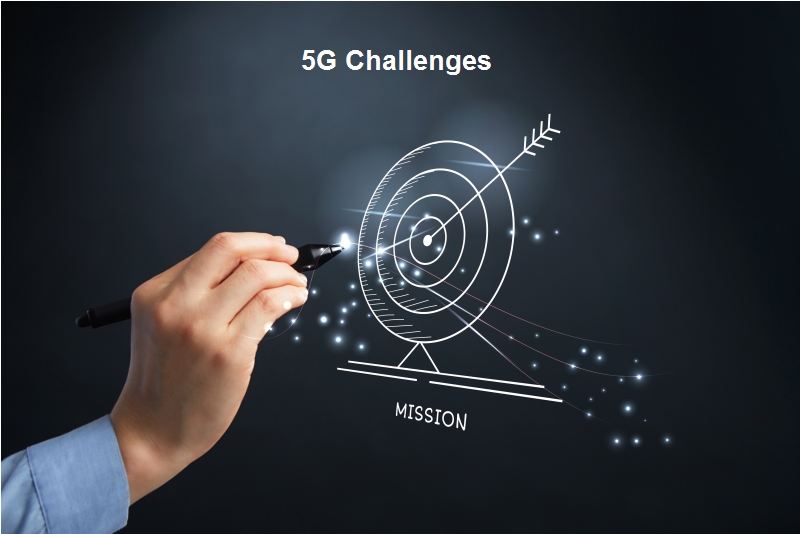Challenges are an unavoidable part of any new growth, and 5G, like all innovations, is no exception. We can see high-speed growth in the past, such as the advent of radio technology. The journey is just about 40 years old, starting at 1G and ending at 5G. (Considering 1G in the 1980s and 5G in 2020s). However, the most common challenges we encountered on this journey were a lack of infrastructure, research methodology, and cost.
 Technological Challenges
Technological Challenges
- Inter-cell Interference: It’s one of the significant technical problems that need to be tackled. Traditional macrocells and concurrent small cells have different sizes, which can cause interference.
- Efficient Medium Access Control: Where a dense deployment of access points and user terminals is needed, user throughput will be poor, latency will be large, and hotspots will not provide high throughput using cellular technology. To optimize the technology, it must be thoroughly researched.
- Traffic Management: In cellular networks, a large number of Machine to Machine (M2M) devices in a cell can cause serious system challenges, such as radio access network (RAN) challenges, which will cause overload and congestion.
Common Challenges
- Multiple Services: Unlike other radio signal systems, 5G will face a significant challenge in providing services to heterogeneous networks, platforms, and devices across several geographic regions. The challenge is standardization to deliver dynamic, universal, user-centric, and data-rich wireless services to meet people’s high standards.
- Infrastructure: The standardization and implementation of 5G networks are posing technical challenges for researchers.
- Communication, Navigation, & Sensing: The existence of a radio spectrum from which signals can be transmitted is critical for these services. While 5G technology has the computing capacity to process massive amounts of data from various sources, it requires more infrastructure support.
- Security and Privacy: It is one of the most critical challenges that 5G must resolve to secure personal data. Security risks, such as trust, privacy, and cyber security, are becoming more prevalent globally, and 5G will have to identify them.
- Legislation of Cyber law: With 5G’s high speed and widespread availability, cyber crime and other forms of fraud will rise. As a result, cyber law regulation is a vital topic that is predominantly a governmental and political (national and international) issue.
- Upgrades to the infrastructure: The mmWave spectrum is much more complex than the low-frequency spectrum, and RF engineers may need specialized training. These aren’t ordinary waves! Low signal coverage and increased reflection from building materials are two of the challenges of designing for mmWave. In-building mmWaves necessitate an infrastructure upgrade, with new antennae, fiber cabling, and small cells mounted throughout a location to communicate appropriately.
- Beamforming’s time commitment: Beamforming, a key feature of 5G NR, allows for ultra-precise data transmission, but it necessitates high-level processing and feedback during the planning and design stages. It’s a strong tool that necessitates a considerable amount of design time.
- The difficulty of achieving secure, consistent low latency: Latency can be disastrous with the 5G set to allow smart technology such as self-driving cars and automated medical equipment. In these industries, precise, well-designed 5G networks are critical for reducing latency.
- Evolutionary costs: The benefits of 5G do not come without a financial commitment. Since most 5G equipment is incompatible with current infrastructure, upgrading a network often necessitates upgrading antenna.
Security Challenges
5G mobile networks will need to communicate with legacy networking solutions and various access technologies to achieve interoperability and ensure the performance assurances outlined above. It requires technological and commercial engagements between different technology providers to ensure seamless mobility, network management, and performance assurance. As a result, given the various types of adjunct networks, devices, and services involved, the protection of 5G networks, systems, and services is now more difficult than that of legacy systems. As a result, security mechanisms for 5G systems must meet the following general requirements:
Cross-layer security: Although various security technologies are successful in their domains. To coordinate these technologies across different security layers, a unified framework is needed. These layers are described as follows in this document:
- Services, Applications, and Use Cases,
- Users and Things
- Inter-networking
- 5G Mobile Network and Virtualization Systems
- Physical Infrastructure
It’s to make sure that a mistake in one layer doesn’t undo the improvements achieved in others.
End-to-end security: End-to-end protection is critical, just as it is in legacy networks, in the communication paths between user devices and the central network termination point, which includes radio access and the transport network backbone. The dispersed and highly scalable design of 5G systems and networks creates new challenges.
Cross-domain security: Interoperability security issues due to the coexistence of various spheres of authority, such as networks, utilities, and equipment. Due to the wide variety of use cases, each with specific and varying performance criteria, coordination and cooperation between parties must ensure that integrated solutions are ultimately safe and cross-layer protection is guaranteed across multiple domains. It should be noted that cross-domain security is not the same as cross-layer security; each domain must enforce cross-layer security to interact with other domains securely.
Secure-by-design: Protection must be considered during the design phase, and security solutions must be implemented quickly. This method eliminates possible holes that could be difficult to close until the system is fully operational.
 Dinesh Thakur holds an B.C.A, MCDBA, MCSD certifications. Dinesh authors the hugely popular
Dinesh Thakur holds an B.C.A, MCDBA, MCSD certifications. Dinesh authors the hugely popular